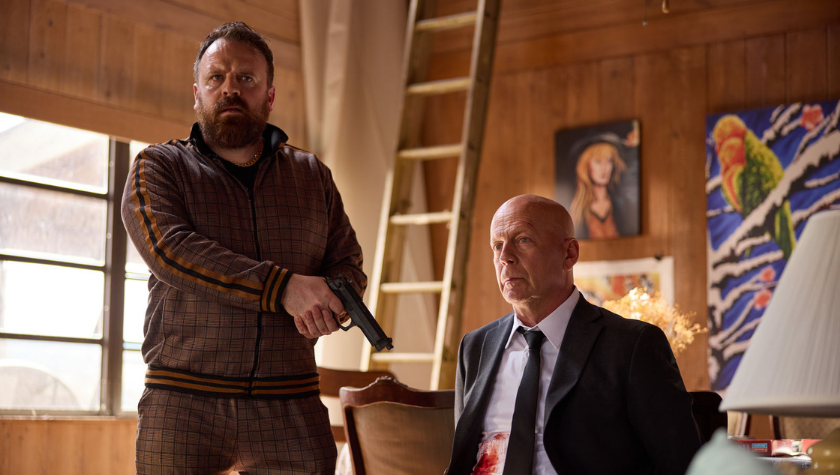How ‘88’ writer-director updates the political conspiracy thriller
June 15, 2022
One of the great things about being a writer is the ability to fall in love with a concept for a story, and then create it. For writer/director Eromose, it was his fascination with political conspiracy thrillers and curiosity about how Super PACs (political action committees) influence public discourse that sparked his desire to write 88.
88 follows a financial director at a Super PAC for politician Harold Roundtree who discovers strange patterns in donations and asks an investment blogger to help him dig deeper into its origins. Both begin to uncover a dark conspiracy that links to white supremacy and is seeping its way into the presidential primaries. The film reveals how campaign finance can be used to plant the seeds of evil in an unknowing mass of people.
Eromose recalls growing up and watching a lot of conspiracy thrillers like The Manchurian Candidate, Parallax View, All the Presidents Men, and JFK. Once he got into filmmaking, he knew he wanted to make a modern conspiracy thriller.
“I moved to America when I was in my late teens and quickly got into American politics,” Eromose shares. “For Citizens United v. FEC and campaign finance scenarios with Super PACs, I found it so fascinating because it was like legalized money laundering and nobody seems to be talking about it.”
He took that idea as a premise and brought in the conversation of race and economics, which he believed was more tied to money and power than anything else. He felt he could use the idea of manipulation of finances through extensive money laundering and connect it with entities that would seek to control the political discourse.
And so, he got to researching and writing.
“The original script I wrote in 2015 and I’ve been writing and rewriting for seven years as different things have happened so this has been a very organic process,” Eromose recalls. It has remained remarkably close in terms of the original spine when the first draft was written as a short film. He decided to expand it because he didn’t have time to say all the things he wanted to say.
The parallels to some of the divisiveness and increased white supremacy rhetoric in the real world since then were mostly coincidental. Eromose admits that real politics didn’t have much of an impact on what he was creating. He was simply more interested in money and Super PACs.
For research, he read books, searched for content online and started talking with someone who worked on one of Hillary Clinton’s 2016 Super PACs who could help him with compliance.
“Everything that I researched I asked him if this could actually happen and he responded that everything technically could happen, although it wasn’t likely.
A fast writing process
Eromose writes all the time and has nearly 150 pilot and feature scripts in his files, although he recognizes that making them all in his lifetime is impossible.
His process starts with an idea, only he doesn’t do much with it when it first pops into his head.
Eromose explains, “I let it sit for a while. Then if the idea is still sticking in my head after a few weeks, I write it down in a short, one-page thing.” From that point, he starts pitching people his idea and gauges their reactions. If it’s positive, he writes an outline.
He spends about 1-2 months on the outline and gets it so detailed that one can almost read the script from it. That gives him the ability to write a fast, fairly-polished first draft in about three weeks.
When it’s time to write the screenplay, he opens up his Final Draft, writes the first page, then walks away. He does this to get the creative juices flowing but doesn’t put much emphasis on what’s there because he knows it won’t stick around.
Regarding that first page, he says, “That’s just to break into the script because usually, the procrastination is in the first page. I never had the first page survive until the end of the script, ever. It’s always different.”
Not so fast: writing the political conspiracy thriller
While Eromose tends to write fast, there is more to it than just outlining and opening up Final Draft. He knows that it takes time to get it right, especially for a political thriller.
He recommends you don't just choose something topical because, with the amount of research you have to do, it will get boring quickly. He stresses that writers must be passionate about whatever issue they’re writing about, then it’s about diligence and compliance
“I was so interested in the subject that it was fun to read and Google all the stuff and interview people,” Eromose says. He continues, “The amount of research I did took years because there’s so much that isn’t even in the film. You have to decide what’s going to be in the movie.”
It’s also critical to find people who are experts on both sides of the issue you’re covering and make sure they can vet the work and give a thumb’s up that everything is accurate.
It all means nothing though if you don’t have compelling characters who can take the audience through the story and who they care about as they navigate through the political landscape you’ve’ created.
Eromose references the Oliver Stone film JFK and the character Garrison: “What Stone does with Garrison is he builds his family first to give you that feeling of knowing who the guy is, where he’s coming from and how his obsession with JFK is affecting his home life. When you go into the story you have a character of significance that you care about.”
Even before the research, Eromose creates the character first – in this case, duo characters: the African American financial director and the Jewish blogger. He thought it would be a cool concept to see these two types of leads fighting against a common enemy.
“I hadn’t seen that before so I came up with that concept,” Eromose recalls of his character creation.
The journey into filmmaking
Eromose moved to Atlanta around the age of 18 and ended up going to Columbia University in New York taking classes in literature and philosophy thinking that he was going to be a lawyer. But his brother felt his talents were in storytelling. Eromose never considered the possibility of being a filmmaker, mostly because, as a Black filmmaker, he didn’t see them making the kind of movies he wanted to make.
“I didn’t want to make Spike Lee-type films, I’m more of a Sidney Lumet guy,” he says. It all changed when he watched Christopher Nolan's Memento and realized he could make a movie out of a concept like that. Spending $9,000 on his student credit card, Eromose made a student film around the Columbia University campus and had it as the first movie at a film festival in Italy that also premiered Nolan’s Batman Begins in 2005.
That success allowed him to moonlight as a script doctor while also writing Legacy, a film that Idris Elba had signed on to star in.
“I sent it to him and at the same time, I was applying to business school. I got a call that he was interested so I had to decide between business school and movies,” Eromose recalls.
Lessons in filmmaking
“Experience is everything,” Eromose states. “I thought I knew everything when I started and found I had a lot to learn. I wouldn’t have been able to make this movie without making the mistakes I made before.”
He also believes writers should create stories they care about and not write to the marketplace. Instead, he suggests writing for yourself and then figuring out how to make that work for the marketplace. “Whether I do my own writing or I’m commissioned to write, it’s the same thing: What is there in me and my experience that I can infuse this with so I can write something that breathes?”
In an homage to his love of the political conspiracy thriller, Eromose has loaded 88 with plenty of Easter eggs. He challenges viewers to find them, although he gives one away: There is a framing from All the Presidents Men when Robert Redford and Dustin Hoffman meet the Washington Post’s editor and pitch him the idea.
“I used the same frame. So, I put every character into the exact same position.”
88 premiered June 11 at the 2022 Tribeca Festival.
Written by: Steven Hartman
Steven Hartman is an award-winning, optioned screenwriter. He was a Top 5 Finalist in Big Break’s Historical Category in 2019 and won Best Action/Adventure in Script Summit’s Screenplay Competition in 2021. He holds a Bachelor of Arts degree from Columbia College and had internships at Jerry Bruckheimer Films and Village Roadshow Pictures. Steve is a full-time writer and creative video producer by day and a screenwriter and novelist by night.



